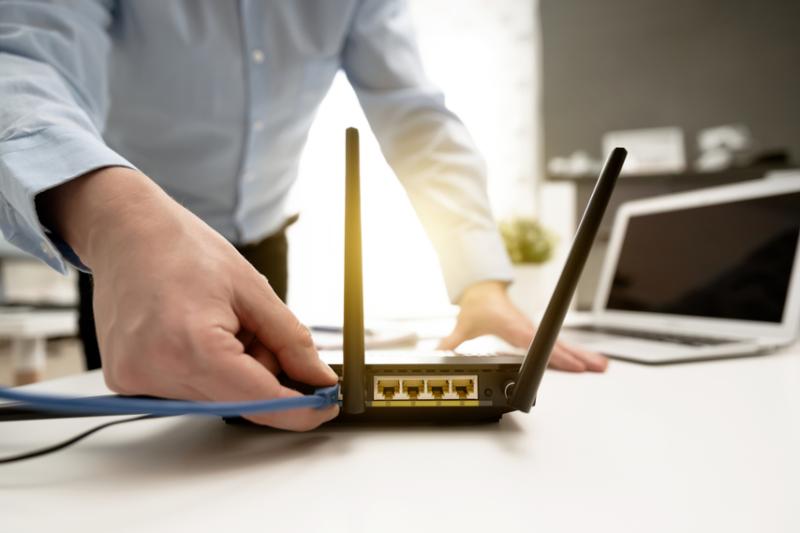How to Fix Slow WiFi at Your New Apartment
You’re all moved in at your new place and ready to kick back with a movie, but your internet is so slow that Netflix barely loads. Or, even worse, you’re preparing to clock in at your remote job — but you’re stuck on what feels like a dial-up connection from the year 2000.
What’s behind this annoyance, and how can you improve WiFi in your apartment? We’ll dive into five of the most common reasons your new apartment’s WiFi might be slow, plus practical tips for how to get better internet in your apartment.

Source: Chay_Tee/Shutterstock
H2 Speed Testing Your WiFi
Your first step should be to speed test your WiFi using one of the many free internet speed tests available online. Test your speed on different devices, in different rooms, and at different times of day, paying attention to when and where the speeds are consistently faster or slower. This can give you valuable information to help determine the cause of your slow WiFi, which we’ll talk more about below.
H2 Five Reasons for WiFi Problems in Apartment Buildings
- Too many devices are using the WiFi network at the same time.
The more devices that use a network, the less data bandwidth will be available to any individual device. The problem can quickly compound itself if you live with one or more other people who are also using their devices simultaneously, especially if they’re streaming media or downloading/uploading big files. If you’re seeing slow speeds during periods when multiple people are using devices, but everything’s fine when you’re home alone, it’s a sign that your problem lies in the number of devices on your network.
- Someone is using your WiFi without permission.
Slow WiFi can also be a sign of an uninvited guest on your network. If your WiFi isn’t adequately secured with a strong password, neighbors or other folks could be getting a free ride at your expense. Worse yet, unauthorized access to your WiFi puts your most important personal data (including bank accounts and medical records) at risk of exposure to cybercriminals.
- Your device is far away from your router.
WiFi is just a radio signal traveling over the airwaves, and like other radio signals, it gets less consistent as the distance between the transmitter and receiver grows. If your router is far away from the spaces where you usually use your devices, and especially if there are multiple walls and/or floors between you and the router, your WiFi speeds might be suffering because of it. This is another easy problem to spot with a speed test, as you’ll find that your speeds substantially increase the closer you get to the router.
- You’re using an older device.
If your WiFi is consistently slower on one device, check which WiFi standards it supports. Older smartphones, laptops, and other devices may not be compatible with the latest WiFi standards. As of 2023, WiFi 6 and WiFi 6E are the latest and best, but many older devices still only support WiFi 5. In addition, check whether your router itself is compatible with WiFi 6/6E. Using an older router, or one that your ISP doesn’t support, can negatively impact your speeds.
- Your internet provider’s data speeds aren’t meeting your needs.
Finally, your WiFi can only be as fast as your connection allows. Check with your internet service provider (ISP) to verify the maximum data speeds you’re paying for. While most connections run slightly below their rated maximum speeds, you should contact your ISP if your speeds are far below what your internet package lists. If your speeds are decent but performance is still slow, it could be that your current service package isn’t enough for your specific needs, particularly if you use high-bandwidth applications like 4K streaming or competitive eSports gaming.

Source: Proxima Studio/Shutterstock
Five Ways to Improve Your Apartment’s WiFi
- Restart your router.
Like many other electronic devices, routers occasionally need to be turned off and rebooted. The process can vary depending on your router model, but it’s usually as simple as unplugging the router, waiting one to two minutes, then plugging it back in. This can be enough to solve the problem on its own, so it’s always worth trying before you dive into other solutions.
- Change your password and make sure you’re using at least WPA2 security.
Having an intruder on your home WiFi isn’t just a hassle that slows down your internet — it’s a genuine security threat. Whether or not you’re sure someone else is using your WiFi, the first step is to make sure you’re using a WiFi router that uses WPA2 encryption. (WPA3 is even better, but not all devices support it yet.)
Next, reset your password using a unique combination of letters, numbers, and symbols. Store it using a secure password manager. If you often have guests using your WiFi, it’s a good idea to create a guest network separate from the one you use for critical personal information.
- Use a dual-band router.
Speaking of multiple networks, getting a dual-band router is another top choice for boosting your apartment’s WiFi speeds. Dual-band routers broadcast WiFi in two separate bands: 2.4GHz and 5GHz. The 2.4GHz band is slower and more interference-prone, but it’s also good for guest networks and low-bandwidth devices like smart home appliances. The faster, less crowded 5GHz band is what most people use for their private personal networks.
Most modern routers already have dual-band capabilities — they just need to be set up to use them. Check your router’s manual for instructions on setting up your multi-band networks. Some even offer “band-splitting” capabilities that allow you to create multiple 5GHz networks if you’d like to give your guests faster WiFi (or create a dedicated network for certain tasks, such as gaming or remote work).
- Consider installing mesh WiFi.
If you can’t move your router closer to where you typically use WiFi, Mesh WiFi might be a good option for you. This technology uses multiple access points throughout a space to provide strong WiFi service on a single network. As you move through your apartment, your mesh network will seamlessly switch to the nearest access point, providing fast and reliable service wherever you are.
Setting up a mesh network is typically straightforward — you’ll just need to purchase a mesh-enabled router and a set of mesh nodes. (Usually, these are available as a package deal.) One extra node is enough for most apartments, but two might be required if you have an exceptionally large space.
- Use Ethernet where you can.
For devices with Ethernet ports, such as desktop PCs, smart TVs, and game consoles, consider connecting to the internet through wired Ethernet rather than WiFi. Since Ethernet connects directly to your device, it’s often significantly faster and more consistent than even the best WiFi — so use it if you have the choice!
- Upgrade your service package, or consider changing providers.
If your current service package doesn’t offer the necessary speeds, it might be time to consider an upgrade. Talk to your ISP and learn what options they offer to get the best internet for your apartment. Depending on where you live, you might even have the choice to upgrade to ultra-fast and reliable fiber internet — an outstanding option if it’s available and within your budget.
On the other hand, if your ISP can’t offer the speeds you need, or your WiFi is still slow even after visits from a service tech, it could be time to search for a new provider. Start by looking up which ISPs are available in your area and examining their offerings. You’ll often be eligible for promotional deals as a new subscriber, but be sure to read any contract carefully to spot potential issues such as introductory rates and cancellation fees.

Source: fizkes/Shutterstock
Slow WiFi is no fun for anybody, and it can definitely put a cramp in living your best life in your new place. With a little smart troubleshooting, though, you’ll be back online — streaming, working, gaming, and enjoying 21st-century speeds.
More to Read:
Previous Posts:










